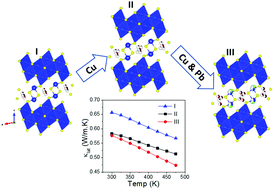Ultralow thermal conductivity through the interplay of composition and disorder between thick and thin layers of makovickyite structure†
Abstract
Here we report the synthesis and characterization of three quaternary complex chalcogenides, Ag0.72Bi5.48Cu0.88S9 (I), Ag0.70Bi5.30Cu1.3S9 (II), Ag0.34Bi4.54Cu1.98PbS9 (III). All the compounds in this homologous series crystallize in the C2/m space group and can be described as Pavonite structures. This structure type consists of alternating NaCl-like layers with varied thickness (nP), separated by a pair of square pyramids. All the compounds reported here are synthetic analogues of the n = 4 pavonite family and are known as makovickyite minerals. Compounds I–III possess complex crystal structures, consisting of mixed occupancies of Bi/Ag/Pb sites, as well as partially occupied Cu sites. These intrinsic assets lead to ultra-low lattice thermal conductivities, in the range of 0.75–0.42 Wm−1 K−1 from 300–500 K, and make these materials promising candidates for thermoelectric applications. All three structures exhibit very narrow indirect band gaps of less than 0.5 eV as confirmed by DRS measurements. Charge transport properties are consistent with n-type semiconducting behavior with moderate electrical conductivities and large Seebeck coefficients. Low temperature electrical resistivity and Seebeck coefficient measurements are also performed on II. A promising figure of merit, zT, of 0.09 for I and II, 0.11 for III can be achieved at 475 K.



 Please wait while we load your content...
Please wait while we load your content...
